|
|
|

Florence et Michel GUERIN |
|
L'irish terrier

-
Le caractère: A l'origine l'irish terrier a
surtout été un "chien de ferme", il débarrassait les
environs immédiats de la ferme des animaux
indésirables et était aussi le chien de la famille, ceci
explique pourquoi il AIME LA COMPAGNIE DES HUMAINS et
aussi les animaux domestiques .
Il est d'un dévouement extrême avec ses maitres et
les aime avec un désintéressement et une fidélité à
toute épreuve, il protège ses enfants et joue avec eux
.Il adore les enfants mais dans un respect mutuel car le
chien , ceci est valable pour toutes les races, n'obéira
pas à l'enfant qu'il prend comme un copain de meute et
non comme un modèle réduit de son maitre, il faut donc
apprendre à l'enfant à respecter le chien et à
comprendre ses règles .
C'est une race de chien particulièrement douée
pour la CYNOTHERAPIE (technique de soins pour les
enfants, malades, vieillards, leur présence amicale
facilite les soins et la guérison psychologique de bien
des patients)
voir définition sur ce site
 Deux
des irish nés dans notre élevage pratiquent cette
discipline avec succès Deux
des irish nés dans notre élevage pratiquent cette
discipline avec succès
Ce n'est pas un chien de chasse , car il ne donne pas de
voix et personne ne sait où il est quand il poursuit sa
proie, néanmoins il a un bon flair. Les américains
prétendent que c'est un chien "de blaireau" , il est
courageux mais prudent malgré son surnom de "
daredevil"( casse-cou en anglais).
C'est un terrier, donc un animal très fier et d'une
intelligence vraiment remarquable , un "décideur" d'où
la facilité de le dresser avec douceur( voir méthode de
"dressage tendresse" dans
dressage) cette méthode lui convient parfaitement car il
obéit pour faire plaisir à son maitre et non pas
contraint et forcé .
Il aime l'exercice( voir sport )
mais se contente de vivre en appartement pourvu que son
maitre soit présent, il préfère son maitre à la liberté!
Il a aussi été utilisé , en temps de guerre, pour passer
d'une tranchée à l'autre et aussi comme kamikaze et
porteur d'explosif ( non volontaire, mais pour plaire à
son maitre ) , ceci lui a valu une distinction militaire
et un monument.
- Les Standards
STANDARD F.C.I.:
n° 139/ 08.11.2002 / F TERRIER IRLANDAIS (Irish
Terrier).
TRADUCTION: Prof. R.
Triquet.
ORIGINE: Irlande.
DATE DE PUBLICATION DU STANDARD
D'ORIGINE EN VIGUEUR: 13/03/2001.
CLASSIFICATION F.C.I.:
Groupe 3 - Terriers Section 1- Terriers de grande et
moyenne taille.
UTILISATION : Chien de ferme
à tout faire, chien de compagnie, chien de garde
montrant le plus grand mépris pour le danger et les
blessures, chien de chasse à courre et à tir.
Sans épreuve de travail.
|
BREF APERÇU HISTORIQUE :
L'Irlande a produit quatre races de terriers et tous
sont nettement différents des terriers du continent et
d'Angleterre.
Il est possible que le chien qui porte actuellement, de
manière officielle, le nom de Terrier irlandais, soit le
terrier le plus ancien d'Irlande, mais il y a si peu de
faits authentifiés qu'il serait difficile d'apporter une
preuve définitive.
Avant les années 1880, la couleur du Terrier Irlandais
n'était pas fixée.
En plus de la robe rouge, il y avait parfois des noirs
et feu et parfois des bringés.
A la fin du 19ème siècle, on s'est efforcé d'éliminer de
l'élevage les noirs et feu et les bringés, de sorte
qu'au 20ème siècle, tous les Terriers Irlandais
portaient la robe rouge.
Ces Terriers Irlandais à robe rouge firent leur
apparition dans les expositions d'Angleterre et des
Etats-Unis où ils furent accueillis avec enthousiasme.
Leur réputation s'accrut encore pendant la première
guerre mondiale, où ils furent utilisés à la
transmission des messages dans le bruit terrifiant et la
confusion de la guerre des tranchées.
Ils donnèrent alors la preuve de leur intelligence et de
leur intrépidité. Le premier club de la race fut créé à
Dublin le 31 mars 1879 et le Terrier Irlandais fut le
premier du groupe des terriers d'Irlande à être reconnu
par le Kennel Club anglais, à la fin du 19ème siècle, en
tant que race d'origine irlandaise.
La réputation qu'a ce chien de se bagarrer avec d'autres
y compris parfois dans le ring d'exposition est
injustifiée.
Bien que ce terrier puisse se montrer ardent quand les
circonstances le demandent, le Terrier Irlandais
s'éduque facilement et c'est un doux compagnon méritant
bien la description qu'on en a donné au début: «
sentinelle du pauvre, ami du paysan, favori de l'homme
de qualité ». |
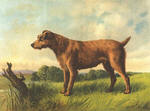
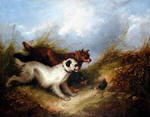
 |
|

ASPECT GENERAL :
Aspect d'un chien actif, agile, tout en muscles et en
nerfs, avec beaucoup de substance, mais en même temps
sans lourdeur, la vitesse et l'endurance étant
essentielles au même titre que la puissance.
Il ne doit être ni grossier dans ses formes ni cob.
Les lignes de sa construction suggèrent la vitesse et
offrent une silhouette élégante et racée.
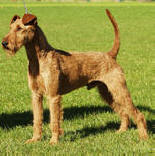

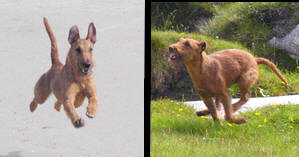 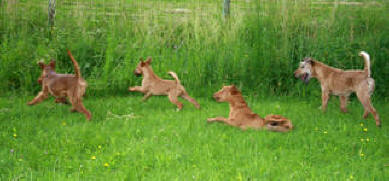
COMPORTEMENT/CARACTERE :
Le Terrier Irlandais, tout en étant plein d'allant et
capable de se faire respecter des autres chiens, est
d'une fidélité remarquable.
Il a bon caractère et il est affectueux avec les hommes,
mais s'il est attaqué, il a le courage du lion et
combattra jusqu'au bout.
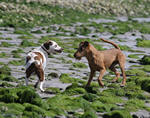
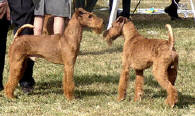

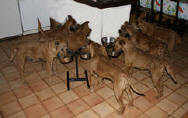


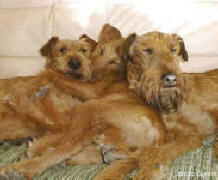

|
|

TÊTE :
Longue, exempte de rides.
Région crânienne :
Crâne : Plat et plutôt
étroit entre les oreilles, devenant légèrement plus
étroit vers les yeux.
Stop : A peine visible, sauf
de profil.
Région faciale :
Truffe : Doit être noire.
Lèvres : Doivent être bien
jointives et extérieurement de couleur presque noire.
Mâchoires : Doivent être
fortes, musclées et de longueur suffisante pour être
redoutables.
Dents : Doivent être fortes,
régulières, saines.
Les incisives supérieures recouvrent légèrement les
inférieures.
Joues : Pas trop chargées,
la région située sous l'œil doit être légèrement déclive
pour éviter l'aspect greyhound.
Yeux : Doivent être de couleur foncée,
petits, non proéminents et pleins de vie, de feu et
d'intelligence. L'œil jaune ou clair est un défaut
grave.
Oreilles : Petites, en forme
de « V », d'épaisseur modérée, bien attachées sur la
tête et tombant en avant tout contre les joues.
La ligne supérieure de l'oreille pliée doit être bien
au-dessus du niveau du crâne.
L'oreille qui pend sur le côté de la tête comme celle
d'un chien courant est atypique chez le Terrier
Irlandais, et l'oreille semi-dressée est un défaut
encore plus grave.
Le poil de l'oreille doit être court et plus foncé que
sur le corps

COU :
Doit être de bonne longueur et s'élargir graduellement
vers les épaules, bien porté, exempt de fanon.
Il y a généralement une sorte de légère collerette de
chaque côté du cou, montant presque jusqu'au coin de
l'oreille
|

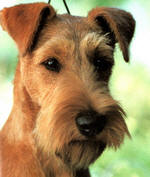
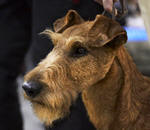
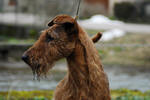 |
|

CORPS : Doit être
bien proportionné, ni trop long ni trop court.
Dos : Doit être fort et
droit, sans manquer le moins du monde de fermeté
derrière les épaules.
Rein : Musclé et très
légèrement voussé.
Le rein peut être légèrement plus long chez la femelle
que chez la mâle.
Poitrine : Haute et musclée,
mais ni en plein cintre ni large.
Les côtes sont assez bien cintrées, plutôt bien
descendues que rondes et bien développées vers
l'arrière.
QUEUE : Doit être
attachée assez haut, portée gaiement, mais pas sur le
dos ni enroulée.
Elle doit être suffisamment forte et avoir de la
substance ; elle est assez longue, la coutume est de
couper la queue de façon à laisser deux tiers de sa
longueur d'origine. Elle est bien couverte de poils
rudes, et ne porte ni frange ni poils longs. La queue
naturelle (non coupée) n'est admise que dans les pays ou
la caudectomie est interdite par la loi.
|
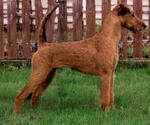
 |
|

MEMBRES : A
l'avant comme à l'arrière, les membres doivent se porter
droit devant.
Membres antérieurs :
Epaules : Doivent être
fines, longues et inclinées.
Coudes : Ils jouent
librement sans être gênés par les côtes.
Avant-bras : Modérément longs,
parfaitement droits, avec une forte ossature et très
musclés.
Métacarpes : Courts et
droits, à peine perceptibles.
Membres postérieurs: Doivent
être forts et musclés.
Cuisses : Puissantes.
Grassets (genoux) :
Modérément angulés.
Jarrets : Près du sol.
Pieds : Doivent être forts,
passablement ronds et modérément petits.
Les doigts cambrés ne sont tournés ni en dehors ni en
dedans.
Les ongles noirs sont très recherchés.
Les coussinets sont sains et ne présentent ni crevasses
ni excroissances cornées.
|
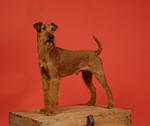
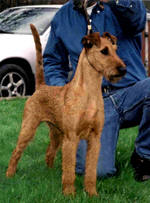 |
|

ALLURES : Les
membres antérieurs et postérieurs se portent droit
devant et sont parallèles.
Les coudes se meuvent dans l'axe du corps et jouent
librement sans être gênés par les côtes.
Les grassets ne sont tournés ni en dedans ni en dehors.
|
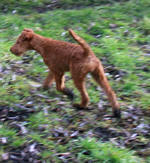
 |
|

ROBE :
Poil : Doit être dense et «
fil de fer » de texture, d'aspect brisé, mais pourtant
couché à plat.
Les poils sont si fortement serrés que, lorsqu'on les
sépare avec les doigts, on ne peut pas voir la peau.
Le poil ne doit être ni mou ni soyeux et n'est pas trop
long au point de cacher les contours du corps, en
particulier aux postérieurs.
Il ne forme ni mèches ni boucles.
Le poil de la face est de même type, mais court (environ
trois quarts de centimètre), presque lisse et droit.
Une légère barbe est le seul poil long qui soit admis
(et il n'est long qu'en comparaison avec le reste) ;
c'est une caractéristique de la race.
Une barbe semblable à celle d'une chèvre évoque la
présence d'un pelage de poils soyeux et de mauvaise
qualité répartis dans le pelage.
Membres exempts de franges et couverts, comme la tête,
d'un poil d'une texture aussi dure que sur le corps,
mais moins long.
Couleur : Doit être
unicolore, rouge, froment rouge ou rouge jaune.
Le blanc apparaît parfois sur le poitrail. Il arrive
fréquemment qu'une petite tache blanche apparaisse dans
toutes les robes unicolores.
|
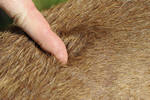
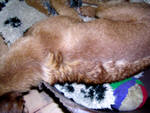
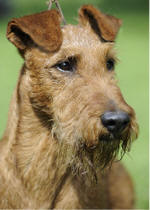
|
|

TAILLE ET POIDS :
Hauteur au garrot : approximativement 18 pouces (45
cm).
Poids : 27 livres anglaises
(12,25kg) chez le mâle. 25 livres anglaises (11,40kg)
chez la femelle.
DEFAUTS : Tout
écart par rapport à ce qui précède doit être considéré
comme un défaut qui sera pénalisé en fonction de sa
gravité.
Défauts éliminatoires :
-Toute autre truffe que noire.
-Prognathisme prononcé, inférieur ou supérieur.
-Toute autre couleur que rouge, rouge-jaune ou
froment-rouge.
Une petite tache de blanc sur le poitrail est admise,
comme chez les autres races unicolores
-Pieds: présence d'excroissance cornées ou de crevasses
sur les coussinets.
N.B.: Les mâles doivent
avoir deux testicules d'apparence normale complètement
descendus dans le scrotum.
|
|
|
|
|
|

Standard américain:
Breed Standard
Head
Long, but in nice proportion to the rest of the body;
the skull flat, rather narrow between the ears, and
narrowing slightly toward the eyes; free from wrinkle,
with the stop hardly noticeable except in profile. The
jaws must be strong and muscular, but not too full in
the cheek, and of good punishing length. The foreface
must not fall away appreciably between or below the
eyes; instead, the modeling should be delicate. An
exaggerated foreface, or a noticeably short foreface,
disturbs the proper balance of the head and is not
desirable. The foreface and the skull from occiput to
stop should be approximately equal in length. Excessive
muscular development of the cheeks, or bony development
of the temples, conditions which are described by the
fancier as "cheeky," or "strong in head," or "thick in
skull" are objectionable. The "bumpy" head, in which the
skull presents two lumps of bony structure above the
eyes, is to be faulted. The hair on the upper and lower
jaws should be similar in quality and texture to that on
the body, and of sufficient length to present an
appearance of additional strength and finish to the
foreface. Either the profuse, goat-like beard, or the
absence of beard, is unsightly and undesirable.
Teeth
Should be strong and even, white and sound; and neither
overshot nor undershot.
Lips
Should be close and well-fitting, almost black in color.
Nose
Must be black.
Eyes
Dark brown in color; small, not prominent; full of life,
fire and intelligence, showing an intense expression.
The light or yellow eye is most objectionable, and is a
bad fault.
Ears
Small and V-shaped; of moderate thickness; set well on
the head, and dropping forward closely toward the
outside corner of the eye. The top of the folded ear
should be well above the level of the skull. A "dead"
ear, hound-like in appearance, must be severely
penalized. It is not characteristic of the Irish
Terrier. The hair should be much shorter and somewhat
darker in color than that on the body.
Neck
Should be of fair length and gradually widening toward
the shoulders; well and proudly carried, and free from
throatiness. Generally there is a slight frill in the
hair at each side of the neck, extending almost to the
corner of the ear.
Shoulders and Chest
Shoulders must be fine, long, and sloping well into the
back. The chest should be deep and muscular, but neither
full nor wide.
Body
The body should be moderately long. The short back is
not characteristic of the Irish Terrier, and is
extremely objectionable. The back must be strong and
straight, and free from an appearance of slackness or
"dip" behind the shoulders. The loin should be strong
and muscular, and slightly arched, the ribs fairly
sprung, deep rather than round, reaching to the level of
the elbow. The bitch may be slightly longer than the
dog.
Hindquarters
Should be strong and muscular; thighs powerful; hocks
near the ground; stifles moderately bent.
Stern
Should be docked, taking off about one quarter. It
should be set on rather high, but not curled. It should
be of good strength and substance; of fair length and
well covered with harsh, rough hair.
Feet and Legs
The feet should be strong, tolerably round, and
moderately small; toes arched and turned neither out nor
in, with dark toenails. The pads should be deep, and
must be perfectly sound and free from corns. Cracks
alone do not necessarily indicate unsound feet. In fact,
all breeds have cracked pads occasionally, from various
causes.
Legs moderately long, well set from the shoulders,
perfectly straight, with plenty of bone and muscle; the
elbows working clear of the sides; pasterns short,
straight, and hardly noticeable. Both fore and hind legs
should move straight forward when traveling; the stifles
should not turn outward. "Cowhocks"--that is, the hocks
turned in and the feet turned out--are intolerable. The
legs should be free from feather and covered with hair
of similar texture to that on the body to give proper
finish to the dog.
Coat
Should be dense and wiry in texture, rich in quality,
having a broken appearance, but still lying fairly close
to the body, the hairs growing so closely and strongly
together that when parted with the fingers the skin is
hardly visible; free of softness or silkiness, and not
so long as to alter the outline of the body,
particularly in the hindquarters. On the sides of the
body the coat is never as harsh as on the back and
quarters, but it should be plentiful and of good
texture. At the base of the stiff outer coat there
should be a growth of finer and softer hair, lighter in
color, termed the undercoat. Single coats, which are
without any undercoat, and wavy coats are undesirable;
the curly and the kinky coats are most objectionable.
Color
Should be whole-colored: bright red, golden red, red
wheaten, or wheaten. A small patch of white on the
chest, frequently encountered in all whole-colored
breeds, is permissible but not desirable. White on any
other part of the body is most objectionable. Puppies
sometimes have black hair at birth, which should
disappear before they are full grown.
Size
The most desirable weight in show condition is 27 pounds
for the dog and 25 pounds for the bitch. The height at
the shoulder should be approximately 18 inches. These
figures serve as a guide to both breeder and judge. In
the show ring, however, the informed judge readily
identifies the oversized or undersized Irish Terrier by
its conformation and general appearance. Weight is not
the last word in judgment. It is of the greatest
importance to select, insofar as possible, terriers of
moderate and generally accepted size, possessing the
other various characteristics.
General Appearance
The over-all appearance of the Irish Terrier is
important. In conformation he must be more than a sum of
his parts. He must be all-of-a piece, a balanced vital
picture of symmetry, proportion and harmony.
Furthermore, he must convey character. This terrier must
be active, lithe and wiry in movement, with great
animation; sturdy and strong in substance and bone
structure, but at the same time free from clumsiness,
for speed, power and endurance are most essential. The
Irish Terrier must be neither "cobby" nor "cloddy," but
should be built on lines of speed with a graceful,
racing outline.
Temperament
The temperament of the Irish Terrier reflects his early
background: he was family pet, guard dog, and hunter. He
is good tempered, spirited and game. It is of the utmost
importance that the Irish Terrier show fire and
animation. There is a heedless, reckless pluck about the
Irish Terrier which is characteristic, and which,
coupled with the headlong dash, blind to all
consequences, with which he rushes at his adversary, has
earned for the breed the proud epithet of "Daredevil."
He is of good temper, most affectionate, and absolutely
loyal to mankind. Tender and forebearing with those he
loves, this rugged, stout-hearted terrier will guard his
master, his mistress and children with utter contempt
for danger or hurt. His life is one continuous and eager
offering of loyal and faithful companionship and
devotion. He is ever on guard, and stands between his
home and all that threatens.
Approved December 10, 1968
|
|

Standard anglais:
General
Appearance
An active, lively and wiry appearance; plenty of
substance but free of clumsiness. Neither cloddy nor
cobby but showing a graceful racy outline.
Characteristics
There is a heedless, reckless pluck about the Irish
Terrier which is characteristic, and, coupled with the
headlong dash, blind to all consequences, with which he
rushes at his adversary, has earned for the breed the
proud epithet of ‘the Daredevils’. When ‘off duty’ they
are characterised by a quiet caress-inviting appearance,
and when one sees them endearingly, timidly pushing
their heads into their master’s hands, it is difficult
to realise that on occasions, at the ‘set on’, they can
prove that they have the courage of a lion, and will
fight to the last breath in their bodies. They develop
an extraordinary devotion for and have been known to
track their masters almost incredible distances.
Temperament
Good-tempered, notably with humans, it being admitted,
however, that he is perhaps a little too ready to resent
interference on the part of other dogs.
Head and
Skull
Head long; skull flat, and rather narrow between ears,
narrowing towards eye; free from wrinkles; stop hardly
visible except in profile. Jaw strong and muscular, but
not too full in cheek, and of good length. Foreface not
dished or falling away quickly between eyes, delicately
chiselled. Lips well fitting and externally almost black
in colour. Nose black.
Eyes
Dark, small, not prominent. A light or yellow eye highly
undesirable.
Ears
Small and V-shaped, of moderate thickness, set well on
head, and dropping forward closely to cheek. Top of
folded ear well above level of skull. Ear must be free
of fringe, and hair thereon shorter and darker in colour
than body.
Mouth
Teeth even, strong and free from discoloration. Jaws
strong, with perfect, regular scissor bite, i.e. upper
teeth closely overlapping lower teeth and set square to
the jaws.
Neck
Fair length and gradually widening towards shoulders,
well carried and free of throatiness. Generally a slight
fringe at each side of neck, running nearly to corner of
ear.
Forequarters
Shoulders fine, long and well laid back. Legs moderately
long, well set from shoulders, perfectly straight, with
plenty of bone and muscle; elbows working freely clear
of sides; pasterns short and straight, hardly
noticeable, the forelegs moved straightforward when
travelling.
Body
Chest deep and muscular, neither full nor wide. Body
moderately long; back strong and straight, with no
appearance of slackness behind shoulders; loin muscular
and slightly arched; ribs fairly sprung, rather deep
than round, and well ribbed back.
Hindquarters
Strong and muscular, thighs powerful, hocks well let
down, stifles moderately bent. Hindlegs move straight
forward when travelling, hocks not turned outwards. Hair
on legs dense and crisp.
Feet
Strong, tolerably round, moderately small, toes arched,
neither turned out nor in; black toe nails most
desirable. Pads sound and free from cracks or horny
excrescences.
Tail
Customarily docked.
Docked: Customarily docked to about three quarters. Free
of fringe or feather, but well covered with rough hair.
Set on pretty high, carried gaily but not over back or
curled.
Undocked: Set on pretty high, carried gaily but not over
back or curled. Free of fringe or feather but well
covered with rough hair. In overall balance with the
rest of the dog. Carriage is such that the tail is not
liable to damage during working.
Gait/Movement
Fore- and hindlegs carried straight forward and
parallel. Elbows move perpendicular to body, working
free of sides, stifles neither turning in nor out.
Coat
Harsh and wiry, having broken appearance, free of
softness or silkiness, not so long as to hide the
outline of body particularly in hindquarters, straight
and flat, no shagginess and free of lock or curl. At
base of these stiff hairs is growth of finer and softer
hair, usually termed the undercoat. Hair on foreface
crisp and only sufficiently long to impart appearance of
additional strength. Hair on legs dense and crisp.
Colour
‘Whole-coloured’, most preferable colours being red,
red/wheaten, or yellow/red. Small amount of white on
chest acceptable, white on feet highly undesirable.
Black shading highly undesirable.
Size
Ideal height: dogs: 48 cms (19 ins); bitches: 46 cms (18
ins).
Faults
Any departure from the foregoing points should be
considered a fault and the seriousness with which the
fault should be regarded should be in exact proportion
to its degree and its effect upon the health and welfare
of the dog.
Note
Male animals should have two apparently normal testicles
fully descended into the scrotum.
July 2001
|
|